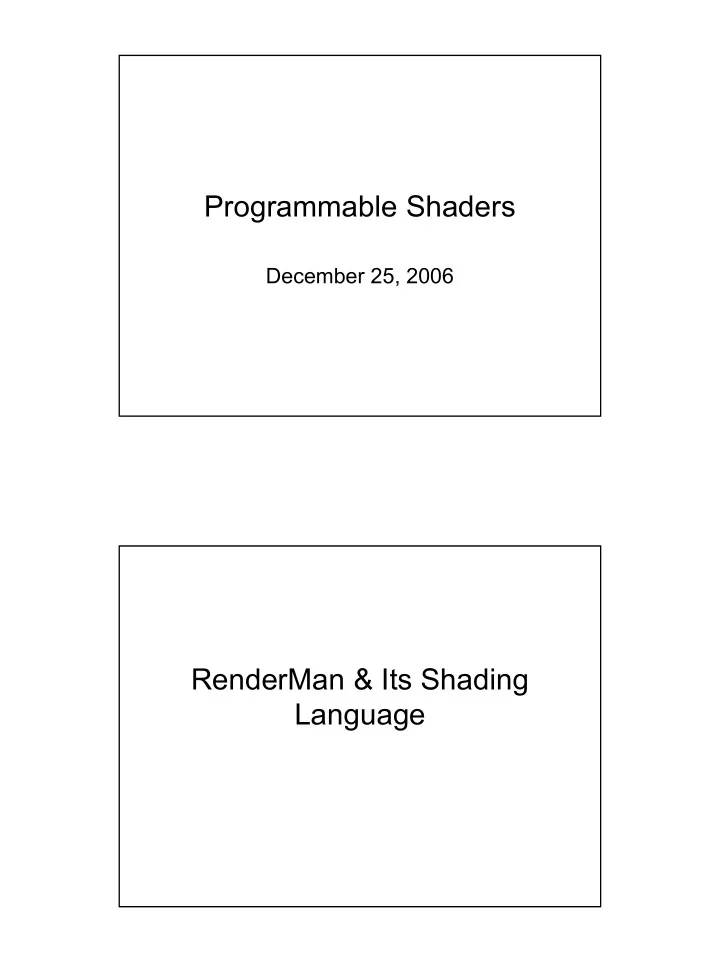

Programmable Shaders December 25, 2006 RenderMan & Its Shading Language
Key Idea of a Shading Language • Image synthesis can be divided into two basic concerns – Shape: Geometric Objects, Coordinates, Transformations, Hidden-Surface Methods … – Shading: Light, Surface, Material, Texture, … • Control shading not only by adjusting parameters and options, but by telling the shader what you want it to do directly in the form of a procedure Pixar ’ s RenderMan • Separation of Modeling and Rendering – RenderMan serves as the interface. • Scene = Shape + Shading • The power of RenderMan is in the shading part.
Example #1: Shape Description #include <ri.h> RtPoint Square[4]={{.5,.5,.5},{.5,-.5,.5}, {-.5,-.5,.5},{-.5,.5,.5}}; Main(){ RiBegin(RI_NULL); RiWorldBegin(); RiSurface(“constant”, RI_NULL); RiPolygon(4, RI_P, (RtPointer)Square, RI_NULL); RiWorldEnd(); RiEnd(); } Example #2: Shading • Colorspheres.c in the BMRT/examples folder.
Building and Running • Must have the following: – Header file: ri.h – Link library – A renderer • The program generates a “RenderMan Interface” file, but doesn’t render it – So that you may pick a renderer that matches the graphics power of your machine. Pixar ’ s RenderMan RIB Rman cc File Rman Geom .rib Program Code render Shader Rman Byte-code Program ( slc ) Shader Shader ( rendrib ) .sl .slc txmake TIFF Rman Image image texture File
RenderMan Interface Spec •Where do you find the meaning of the arguments to those Ri…() functions? – Check the spec! (available directly from Pixar). – Appendix G contains a quick reference. http://www.pixar.com/renderman/developers_corner /rispec/rispec_pdf/RISpec3_2.pdf Shading Language • Many types of shaders are possible: – Light source shaders – Surface shaders – Atmosphere shaders – Volume shaders…etc. • We will discuss only the surface shaders.
Shader Writing • Global variables: (from Table 14.2 of The RenderMan Companion book) – Camera position, surface color/opacity, surface position/normal, texture coordinates…etc. – Must output: color of light from surface, opacity of surface. • Many built-in operators (Table 14.4) and functions (Ch.15, Tables 15.1-15.2). Example: Plastic Surface surface plastic (float Ka = 1, Kd = 0.5, Ks = 0.5, roughness = 0.1; color specularcolor = 1) { normal Nf = faceforward (normalize(N),I); Ci = Cs * (Ka*ambient() + Kd*diffuse(Nf)) + specularcolor * Ks*specular(Nf,-normalize(I),roughness); Oi = Os; Ci *= Oi; }
RenderMan ’ s Shader • Phong shader surface phong( float Ka = 1, Kd =1, Ks = 0.5; float roughness = 0.1; color specularcolor = 1; ) { normal Nf = faceforward( normalize(N), I ); vector V = -normalize(I); color C = 0; illuminance( P ) { vector R = 2*normalize(N)* (normalize(N) . normalize( L )) - normalize( L ); C += Ka*Cs + Kd*Cs*( normalize(N) . normalize(L) ) + Ks*specularcolor* pow(( R . V ), 10); } Ci = C*Cs; } RenderMan ’ s Shader -2 • Attaching to the RIB file *********** AttributeBegin Translate 0 -1.5 0 Rotate 20 0 0 1 Color [ 0.8 0.0 0.0 ] Surface "phong" "Ka" [.1] "Kd" [.8] "Ks" [1] "roughness" [0.1] "specularcolor" [1 1 1] Basis "bezier" 3 "bezier" 3 PatchMesh "bicubic" 13 "nonperiodic" 10 "nonperiodic" "P" [1.5 0 0 1.5 0.828427 0 0.828427 1.5 0 0 1.5 0 -0.828427 1.5 0 -1.5 0.828427 0 -1.5 0 0 -1.5 -0.828427 0 -0.828427 -1.5 0 0 -1.5 0 0.828427 -1.5 0 1.5 -0.828427 0 1.5 0 0 1.5 0 0.075 1.5 0.828427 0.075 0.828427 1.5 0.075 0 1.5 0.075 - 0.828427 1.5 0.075 -1.5 0.828427 0.075 -1.5 0 0.075 -1.5 -0.828427 0.075 -0.828427 -1.5 0.075 0 -1.5 0.075 0.828427 -1.5 0.075 1.5 -0.828427 0.075 1.5 0 0.075 2 0 0.3 2 1.10457 0.3 1.10457 2 0.3 0 2 0.3 - 1.10457 **************
Gallery of Shaders • Procedural textures: e.g., wood • Bump mapping and displacement mapping. • For more, see Ch. 16 of The RenderMan Companion • See also the shaders and examples folders of BMRT.
A Few Stories … • The shader concept first appears in the REYES paper. • The programmable shader first appears in graphics hardware in UNC ’ s PixelFlow [Olano97]. Many folks in the PixelFlow team are now at NVIDIA. • The co-author of PBRT and the creator of BMRT (Larry Gritz) were cofounders of Exluna REYES • From Cook et al. “ The Reyes Image Rendering Architecture ” SIGGRAPH 87. • Subdivide a surface into micropolygons.
BMRT • A public-domain implementation of Pixar Photorealistic RenderMan (PRMan). • Three main components: – Rendrib: the renderer – Rgl: quick rendering for preview – Slc: shading language compiler Shading Languages for Graphics Hardware
21 Bump Map Example • Bump mapping simulates detail with a surface normal that varies across a surface 22
RenderMan Example displacement lumpy ( float Km = 1, frequency = 1, maxoctaves = 6; string shadingspace = "shader"; float truedisp = 1;) { point Pshad = transform (shadingspace, frequency*P); float dPshad = filterwidthp(Pshad); float magnitude = fBm (Pshad, dPshad, maxoctaves, 2, 0.5); N = Displace (normalize(N), shadingspace, Km*magnitude, truedisp); } 23 Cg Example f2fb DiffuseBumpPS(v2f IN, uniform sampler2D DiffuseMap, uniform sampler2D NormalMap, uniform float4 bumpHeight) { f2fb OUT; float4 color = tex2D(DiffuseMap); //fetch base color //fetch bump normal float4 bumpNormal = expand(tex2D(NormalMap)) * bumpHeight; //expand iterated light vector to [-1,1] float4 lightVector = expand(passthrough(IN.LightVector)); //compute final color (diffuse + ambient) float4 bump = uclamp(dot3_rgba(bumpNormal.xyz, lightVector.xyz)); OUT.col = color * bump; return OUT; } 24
25
Recommend
More recommend